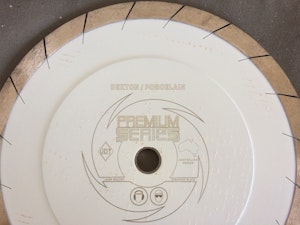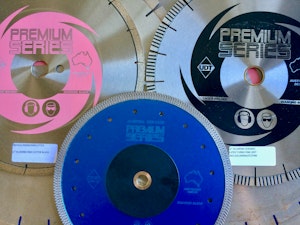What are they?
Diamond blades consist of a steel core with segments that contain artificial industrial diamonds and are used for cutting reinforced concrete , masonry and other materials.
Abrasive blades consist of grit bonded with a binder, and often reinforced with a fabric base. These blades are ideal for dry cutting of materials such as steel, steel alloys, cast and ductile iron that do not create silica dust.
What are diamond blades made of?
Diamond Crystals
These are the cutting agents and come in different grit sizes, quality and quantity. All are industrial grade diamonds, which are manufactured, not mined.
Coarse diamonds will remove more material than finer diamond particles and will cut faster. However, the trade-off is an increase in chipping.
Finer diamonds will cut finer, but slower.
- Coarse diamond grits are used for most masonry, concrete, refractory and natural stone products.
- Medium diamond grit is used for most industrial materials such as ceramic, quartz, glass, porcelain, hard and brittle materials etc.
- Fine diamond grit is used for extremely smooth cutting, grinding and polishing.
Bonding System
Bonding systems, or matrix, hold the diamond crystals and play important roles by:
- Supporting the diamonds
- Allow the diamond to protrude by controlled wear to allow the blade to have a continual refreshment at the cutting edge
- Prevent the diamond being exposed until ready
- Acts as an absorbent heat sink
- Allows control of impact and load as the diamonds grind and cut the product
- Correct bonding systems for the product being cut extends the life of the blade
Segments
These are a combination of crystals and bonding system that are manufactured into segments that are wider than the blade's steel core to provide clearance while cutting. These segments vary in strength of bond. Generally, softer bonds are used for harder products being cut and harder bonds for softer products.
Laser Welding
Laser welding is the method used to secure the diamond segment to the steel core. This is a far superior method to sintering, which can allow segments to fly off if the blade over heats when operating - a very dangerous situation! As precision laser welding adds to the cost of manufacturing the blade, it tends to be mainly used in the higher value, better quality products - like United Diamond Tools blades.
Undercut Protection
Undercut protection is usually found on floor saw and hand saw blades. If the blade cuts through what it is supposed to be cutting (for example, asphalt) and cuts into road base, the undercut segment protects the area where the segments join the blade body. Without undercut protection, the result could be the loss of a segment, potentially hitting the operator or bystanders.
Steel Core
The segments are attached to a steel disc that is tensioned during manufacture and usually has gullets (or slots) to provide increased cooling by the introduction of air or water flow. It is important that the steel cores are flexible enough to allow some flexing of the blade while under cutting pressure. An arbor hole is positioned in the centre of the bade and can vary in size to suit specific machines. Some steel cores are layered and tensioned, and this creates a "silenced" blade that does not "sing" when used on a brick saws.
What are the different blade styles?
Segmented Rim

The segmented rim blade gives the roughest cut and this style of blade is used for cutting concrete, hard/reinforced concrete, bricks, concrete pavers, masonry blocks and limestone. This blade is usually referred to as a dry cutting blade, although it will always last longer when used with water. The cut outs, or gullets, on the edge of the blade allow for cooling of the blade core and allow for better exhaust of debris, giving a swifter cut. Segmented blades are the best option when water is not available (for example rescue operations) but it is going to be a rougher cut, leaving a poorer finish when compared to other blades.
Turbo rim blade

The Turbo Rim blade is designed specifically to cut faster in wet or dry applications. The smaller serrated segments on the rim allow for cooling of the blade. Due to the design, this blade cuts faster as the turbo segments push the waste material out. This blade cuts effectively brick, concrete and limestone.
Continuous Rim
The Continuous Rim blade is commonly referred to as a wet cut blade. The style of blade cuts the slowest of any of the different diamond saw blades, but it produces the best cut. Typically, the continuous rim is used for cutting alumina ceramic, granite, marble, and ceramic and porcelain tiles.
